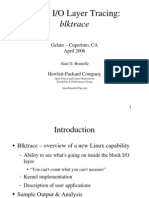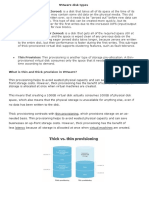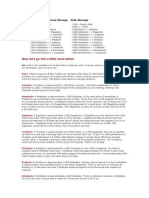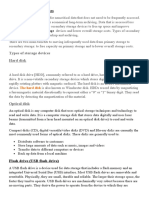6.3. Tools Red Hat Product Documentation
6.3. Tools Red Hat Product Documentation
Uploaded by
黃文西Copyright:
Available Formats
6.3. Tools Red Hat Product Documentation
6.3. Tools Red Hat Product Documentation
Uploaded by
黃文西Copyright
Available Formats
Share this document
Did you find this document useful?
Is this content inappropriate?
Copyright:
Available Formats
6.3. Tools Red Hat Product Documentation
6.3. Tools Red Hat Product Documentation
Uploaded by
黃文西Copyright:
Available Formats
6.3. Tools | Red Hat Product Documentation https://docs.redhat.com/en/documentation/red_hat_en...
Back to top
第 1 ⾴,共 6 ⾴ 2024/12/8 21:01
6.3. Tools | Red Hat Product Documentation https://docs.redhat.com/en/documentation/red_hat_en...
6.3. Tools
There are a number of tools available to help diagnose performance problems in the I/O subsystem.
provides a coarse overview of system performance. The following columns are most relevant to I/O: si (swap
in), so (swap out), bi (block in), bo (block out), and wa (I/O wait time). si and so are useful when your
swap space is on the same device as your data partition, and as an indicator of overall memory pressure. si
and bi are read operations, while so and bo are write operations. Each of these categories is reported in
kilobytes. wa is idle time; it indicates what portion of the run queue is blocked waiting for I/O complete.
Analyzing your system with will give you an idea of whether or not the I/O subsystem may be
responsible for any performance issues. The free , buff , and cache columns are also worth noting. The
cache value increasing alongside the bo value, followed by a drop in cache and an increase in free indicates
that the system is performing write-back and invalidation of the page cache.
Note that the I/O numbers reported by are aggregations of all I/O to all devices. Once you have
determined that there may be a performance gap in the I/O subsystem, you can examine the problem more
closely with , which will break down the I/O reporting by device. You can also retrieve more detailed
information, such as the average request size, the number of reads and writes per second, and the amount of
I/O merging going on.
Using the average request size and the average queue size ( avgqu-sz ), you can make some estimations about
how the storage should perform using the graphs you generated when characterizing the performance of your
storage. Some generalizations apply: for example, if the average request size is 4KB and the average queue size
is 1, throughput is unlikely to be extremely performant.
If the performance numbers do not map to the performance you expect, you can perform more �ne-grained
analysis with . The suite of utilities gives �ne-grained information on how much time is spent
in the I/O subsystem. The output from is a set of binary trace �les that can be post-processed by
other utilities such as .
is the companion utility to . It reads the raw output from the trace and produces a short-
hand textual version.
The following is an example of output:
8,64 3 1 0.000000000 4162 Q RM 73992 + 8 [fs_mark]
8,64 3 0 0.000012707 0 m N cfq4162S / alloced
8,64 3 2 0.000013433 4162 G RM 73992 + 8 [fs_mark]
8,64 3 3 0.000015813 4162 P N [fs_mark]
8,64 3 4 0.000017347 4162 I R 73992 + 8 [fs_mark]
8,64 3 0 0.000018632 0 m N cfq4162S / insert_request
8,64 3 0 0.000019655 0 m N cfq4162S / add_to_rr
8,64 3 0 0.000021945 0 m N cfq4162S / idle=0
8,64 3 5 0.000023460 4162 U N [fs_mark] 1
8,64 3 0 0.000025761 0 m N cfq workload slice:300
8,64 3 0 0.000027137 0 m N cfq4162S / set_active wl_prio:0 wl_type:2 Back to top
8,64 3 0 0.000028588 0 m N cfq4162S / fifo=(null)
第 2 ⾴,共 6 ⾴ 2024/12/8 21:01
6.3. Tools | Red Hat Product Documentation https://docs.redhat.com/en/documentation/red_hat_en...
8,64 3 0 0.000029468 0 m N cfq4162S / dispatch_insert
8,64 3 0 0.000031359 0 m N cfq4162S / dispatched a request
8,64 3 0 0.000032306 0 m N cfq4162S / activate rq, drv=1
8,64 3 6 0.000032735 4162 D R 73992 + 8 [fs_mark]
8,64 1 1 0.004276637 0 C R 73992 + 8 [0]
As you can see, the output is dense and dif�cult to read. You can tell which processes are responsible for issuing
I/O to your device, which is useful, but can give you additional information in an easy-to-digest
format in its summary. summary information is printed at the very end of its output:
Total (sde):
Reads Queued: 19, 76KiB Writes Queued: 142,183, 568,732KiB
Read Dispatches: 19, 76KiB Write Dispatches: 25,440, 568,732KiB
Reads Requeued: 0 Writes Requeued: 125
Reads Completed: 19, 76KiB Writes Completed: 25,315, 568,732KiB
Read Merges: 0, 0KiB Write Merges: 116,868, 467,472KiB
IO unplugs: 20,087 Timer unplugs: 0
The summary shows average I/O rates, merging activity, and compares the read workload with the write
workload. For the most part, however, output is too voluminous to be useful on its own. Fortunately,
there are several tools to assist in visualizing the data.
provides an analysis of the amount of time the I/O spent in the different areas of the I/O stack. These areas
are:
• Q — A block I/O is Queued
• G — Get Request
A newly queued block I/O was not a candidate for merging with any existing request, so a new block layer
request is allocated.
• M — A block I/O is Merged with an existing request.
• I — A request is Inserted into the device's queue.
• D — A request is issued to the Device.
• C — A request is Completed by the driver.
• P — The block device queue is Plugged, to allow the aggregation of requests.
• U — The device queue is Unplugged, allowing the aggregated requests to be issued to the device.
breaks down the time spent in each of these areas, as well as the time spent transitioning between them,
like so:
• Q2Q — time between requests sent to the block layer
• Q2G — how long it takes from the time a block I/O is queued to the time it gets a request allocated for it
Back to top
• G2I — how long it takes from the time a request is allocated to the time it is Inserted into the device's queue
第 3 ⾴,共 6 ⾴ 2024/12/8 21:01
6.3. Tools | Red Hat Product Documentation https://docs.redhat.com/en/documentation/red_hat_en...
• G2I — how long it takes from the time a request is allocated to the time it is Inserted into the device's queue
• Q2M — how long it takes from the time a block I/O is queued to the time it gets merged with an existing
request
• I2D — how long it takes from the time a request is inserted into the device's queue to the time it is actually
issued to the device
• M2D — how long it takes from the time a block I/O is merged with an exiting request until the request is
issued to the device
• D2C — service time of the request by the device
• Q2C — total time spent in the block layer for a request
You can deduce a lot about a workload from the above table. For example, if Q2Q is much larger than Q2C, that
means the application is not issuing I/O in rapid succession. Thus, any performance problems you have may not
be at all related to the I/O subsystem. If D2C is very high, then the device is taking a long time to service
requests. This can indicate that the device is simply overloaded (which may be due to the fact that it is a shared
resource), or it could be because the workload sent down to the device is sub-optimal. If Q2G is very high, it
means that there are a lot of requests queued concurrently. This could indicate that the storage is unable to
keep up with the I/O load.
Finally, consumes binary data and generates a set of plots, including Logical Block
Address (LBA), throughput and seek operations per second.
Back to top
第 4 ⾴,共 6 ⾴ 2024/12/8 21:01
6.3. Tools | Red Hat Product Documentation https://docs.redhat.com/en/documentation/red_hat_en...
View larger image ⿻
All plots use time as the X axis. The LBA plot shows reads and writes in different colors. It is interesting to note
the relationship between the throughput and seeks/sec graphs. For storage that is seek-sensitive, there is an
inverse relation between the two plots.
Previous Next
Back to top
第 5 ⾴,共 6 ⾴ 2024/12/8 21:01
6.3. Tools | Red Hat Product Documentation https://docs.redhat.com/en/documentation/red_hat_en...
Back to top
第 6 ⾴,共 6 ⾴ 2024/12/8 21:01
You might also like
- Fundamentals of Ict NotesDocument60 pagesFundamentals of Ict NotesBria90% (41)
- Software-Defined Networks: A Systems ApproachFrom EverandSoftware-Defined Networks: A Systems ApproachRating: 5 out of 5 stars5/5 (1)
- 3.2.1.4 Lab - Locating Log FilesDocument16 pages3.2.1.4 Lab - Locating Log FilesKamNo ratings yet
- 4.4.4 Lab Locating Log FilesDocument17 pages4.4.4 Lab Locating Log FilesEnrique JuárezNo ratings yet
- Atollic Serial Wire Viewer Realtime Tracing WhitepaperDocument20 pagesAtollic Serial Wire Viewer Realtime Tracing Whitepaperzbhp zNo ratings yet
- 3.2.1.4 Lab - Locating Log FilesDocument17 pages3.2.1.4 Lab - Locating Log Filestukang rusuhNo ratings yet
- Monitoring Issues: A Guide For BeginnersDocument19 pagesMonitoring Issues: A Guide For BeginnersAGUSTIN RAFAEL MIRANDA PUPONo ratings yet
- BlktraceDocument18 pagesBlktraceHoyoonJunNo ratings yet
- Lab - Locating Log Files: ObjectivesDocument16 pagesLab - Locating Log Files: ObjectivesgeorgeNo ratings yet
- BCSP 801 Aos Lab FileDocument29 pagesBCSP 801 Aos Lab FileParas SharmaNo ratings yet
- Lab6 ASICDocument8 pagesLab6 ASICpskumarvlsipdNo ratings yet
- A Proposal On The Design and Implementation of An Advanced 8085 Microprocessor Trainer ModuleDocument8 pagesA Proposal On The Design and Implementation of An Advanced 8085 Microprocessor Trainer ModuleSolomon AkpanNo ratings yet
- Awr Report AnalysisDocument13 pagesAwr Report Analysissrinivas1224No ratings yet
- What To DoDocument21 pagesWhat To DoJanviNo ratings yet
- Zookeeper ProgrammersDocument20 pagesZookeeper ProgrammerspeterguanNo ratings yet
- IADC Daily Drilling Report RevADocument8 pagesIADC Daily Drilling Report RevAtxcrudeNo ratings yet
- EHW Software ProposalDocument11 pagesEHW Software ProposalMemo DinoNo ratings yet
- Hitachi Unified Compute Platform 1000 For Vmware Evo:Rail Installation and Reference ManualDocument95 pagesHitachi Unified Compute Platform 1000 For Vmware Evo:Rail Installation and Reference ManualVương NhânNo ratings yet
- Titanic: Mohit Kothari Roger Tanuatmadja Gautam AkiwateDocument18 pagesTitanic: Mohit Kothari Roger Tanuatmadja Gautam AkiwatezarthonNo ratings yet
- 3.2.1.4 Lab - Locating Log FilesDocument21 pages3.2.1.4 Lab - Locating Log FilesMUHAMMAD RIDHAN KHOIRULLAHNo ratings yet
- Mainframe Architecture Product Overview 1218153498319609 9Document69 pagesMainframe Architecture Product Overview 1218153498319609 9adrianpurbamanahanNo ratings yet
- User'S Guide: Openstack Deployment With Sr-Iov ConfigurationDocument32 pagesUser'S Guide: Openstack Deployment With Sr-Iov ConfigurationAlex10505No ratings yet
- QSG0007-UR20-Modbus Understanding Coils and RegisterDocument20 pagesQSG0007-UR20-Modbus Understanding Coils and RegisterUiliansNo ratings yet
- 3.2.1.4 Lab Locating Log FilesDocument16 pages3.2.1.4 Lab Locating Log FilesMICAH WALDRONNo ratings yet
- DFCR Project Description-Arduino MKRDocument12 pagesDFCR Project Description-Arduino MKRfthpmnafidfwbacrcjNo ratings yet
- Linux Con 2010 Linux MonitoringDocument44 pagesLinux Con 2010 Linux MonitoringArsalan QureshiNo ratings yet
- Modbus Application Protocol V1 1bDocument51 pagesModbus Application Protocol V1 1bAlexander E. GuzmanNo ratings yet
- 4.4.4 Lab Locating Log FilesDocument17 pages4.4.4 Lab Locating Log FilesMustafa AkbarNo ratings yet
- Duct Size 6 (User Manual)Document231 pagesDuct Size 6 (User Manual)abbasrayansabaNo ratings yet
- Innovus Study Notes-CSDN BlogDocument6 pagesInnovus Study Notes-CSDN BlogAgnathavasiNo ratings yet
- 444 Lab Locating Log FilesDocument22 pages444 Lab Locating Log FilesEnrique JuárezNo ratings yet
- 78-738184-01_BDocument20 pages78-738184-01_BFredy benitesNo ratings yet
- BHUSA09 Neilson NetscreenDead PAPERDocument24 pagesBHUSA09 Neilson NetscreenDead PAPERNguyen NMNo ratings yet
- List of Test ItemsDocument43 pagesList of Test ItemskltowerNo ratings yet
- Sap BW Int QuestionsDocument48 pagesSap BW Int QuestionssureshNo ratings yet
- Hunting Down CPU Related Issues With Oracle: A Functional ApproachDocument9 pagesHunting Down CPU Related Issues With Oracle: A Functional ApproachphanithotaNo ratings yet
- Configure Debug Complex Clock Network CCOptDocument41 pagesConfigure Debug Complex Clock Network CCOptANSHITA100% (2)
- OPC UA Client Development With NET StandardDocument41 pagesOPC UA Client Development With NET StandardJeremy80100% (1)
- Interview QuestionDocument31 pagesInterview Questionapi-3838570100% (1)
- RFC 7539Document45 pagesRFC 7539cbetterNo ratings yet
- Reading Statspack ReportDocument24 pagesReading Statspack Reportravtank1982_28100% (1)
- The Flancter DoulosDocument2 pagesThe Flancter DoulosMiguel BrunoNo ratings yet
- Blktrace UsageDocument22 pagesBlktrace Usageqexing100% (2)
- Oracle Performance Tuning CaseDocument21 pagesOracle Performance Tuning CaseEdwin Gauta TorresNo ratings yet
- Troubleshooting Guide For Wireless ClientsDocument22 pagesTroubleshooting Guide For Wireless ClientsLeonardo SuarezNo ratings yet
- How To Read Awr ReportDocument22 pagesHow To Read Awr Reportsoma3nathNo ratings yet
- Payroll Management SystemDocument16 pagesPayroll Management Systemphyllis MensahNo ratings yet
- Benchmarking Single-Point Performance On National Instruments Real-Time HardwareDocument8 pagesBenchmarking Single-Point Performance On National Instruments Real-Time HardwaremafmonteNo ratings yet
- RapidWright Tutorials (3) .OdtDocument17 pagesRapidWright Tutorials (3) .OdtSrijeet GuhaNo ratings yet
- Linux 4.10Document19 pagesLinux 4.10aio2No ratings yet
- Scan Ubuntu With OSSEC + Postfix Prepare For PCI-DSS 0unmp9Document45 pagesScan Ubuntu With OSSEC + Postfix Prepare For PCI-DSS 0unmp9Yudi 'Goemon' PrabowoNo ratings yet
- SoftwareDefinedNetworking - A Comprehensive Survey (31-63)Document33 pagesSoftwareDefinedNetworking - A Comprehensive Survey (31-63)Brissa CoralTorresNo ratings yet
- BRKRST-3066 Troubleshooting Nexus 7000Document74 pagesBRKRST-3066 Troubleshooting Nexus 7000Kevin KimNo ratings yet
- Avaya VoIP Network AssessmentDocument16 pagesAvaya VoIP Network AssessmentbartophNo ratings yet
- BD Sqltohadoop3 PDFDocument13 pagesBD Sqltohadoop3 PDFherotestNo ratings yet
- InfluxDB OSS Onboarding GuideDocument73 pagesInfluxDB OSS Onboarding GuideVera SimilarNo ratings yet
- SAS Programming Guidelines Interview Questions You'll Most Likely Be AskedFrom EverandSAS Programming Guidelines Interview Questions You'll Most Likely Be AskedNo ratings yet
- Engineering the CMOS Library: Enhancing Digital Design Kits for Competitive SiliconFrom EverandEngineering the CMOS Library: Enhancing Digital Design Kits for Competitive SiliconRating: 1 out of 5 stars1/5 (1)
- Homework #6 - : Questions: AnswersDocument2 pagesHomework #6 - : Questions: Answersbunty daNo ratings yet
- VMWARE THICK and THIN DiskDocument20 pagesVMWARE THICK and THIN Diskviveksabc123No ratings yet
- Experiment-1 Digital Forensics AIM-Using FTK Imager DATE: 21-01-2021Document10 pagesExperiment-1 Digital Forensics AIM-Using FTK Imager DATE: 21-01-2021TANISHA PATHAKNo ratings yet
- AWS S3 CheatsheetDocument10 pagesAWS S3 CheatsheetAaron GuildNo ratings yet
- SEG-D, Rev 2: SEG Field Tape Standards December, 1996Document65 pagesSEG-D, Rev 2: SEG Field Tape Standards December, 1996Liavon SokalNo ratings yet
- PC Core EstorilDocument44 pagesPC Core Estorilsafa.ismail.safa100% (1)
- Computer - MemoryDocument3 pagesComputer - MemoryジョージNo ratings yet
- Memory HierarchyDocument16 pagesMemory HierarchyAnime LegacyNo ratings yet
- Module 05 Understanding Storage Media and File SystemDocument29 pagesModule 05 Understanding Storage Media and File Systemrohan0x80No ratings yet
- Practice Set of Types of HardwareDocument3 pagesPractice Set of Types of HardwareAmit KumarNo ratings yet
- StorelibdebugDocument2 pagesStorelibdebugAlexandre Gibert MWNo ratings yet
- X-75m2 Data Sheet SA-MxAK JUx Rev107Document23 pagesX-75m2 Data Sheet SA-MxAK JUx Rev107chassisdNo ratings yet
- 1.2 RAID - Redundant Array of Independent DisksDocument22 pages1.2 RAID - Redundant Array of Independent Disks20C134-SRIKRISHNA MNo ratings yet
- Co3 Ppt-Part2Document24 pagesCo3 Ppt-Part2sumeddha SivakotiNo ratings yet
- Exadata Database Machine Administration Workshop Ed 3: D86531 5 Giorni 4.445,00 Italiano Virtual Classroom Corso in AulaDocument9 pagesExadata Database Machine Administration Workshop Ed 3: D86531 5 Giorni 4.445,00 Italiano Virtual Classroom Corso in AulaGreene ChickaNo ratings yet
- M2221STORAGEDocument2 pagesM2221STORAGEDhairya AilaniNo ratings yet
- Lesson 3: Processing Data: Transforming Data Into InformationDocument21 pagesLesson 3: Processing Data: Transforming Data Into InformationNiña Mae C. QuiambaoNo ratings yet
- Processing and Storage DevicesDocument35 pagesProcessing and Storage DevicesPasngadan, Jensen Rowie D.No ratings yet
- BytesDocument2 pagesBytesqamershahzadNo ratings yet
- Cpe111-Lesson-5 Parts of ComputerDocument81 pagesCpe111-Lesson-5 Parts of ComputerLance AsioNo ratings yet
- New HCSP Word ExamDocument16 pagesNew HCSP Word Exammabdro170No ratings yet
- 3390 Disks and Channel SpeedsDocument4 pages3390 Disks and Channel SpeedsAtthulaiNo ratings yet
- Types of Storage Devices Hard DiskDocument3 pagesTypes of Storage Devices Hard DiskAvisek shresthaNo ratings yet
- Ict 3Document10 pagesIct 3Kalule CyprianNo ratings yet
- Byte, Kilobyte, Megabyte, GigabyteDocument3 pagesByte, Kilobyte, Megabyte, Gigabytesan nicolasNo ratings yet
- Filing NotesDocument27 pagesFiling NotesDAN OSSONo ratings yet
- 420 CDTDocument201 pages420 CDTMatheus CarvalhalNo ratings yet
- Types of Storage Devices: ProposalDocument3 pagesTypes of Storage Devices: Proposalgirish desaiNo ratings yet
- Types of Components and Objects To Be Measured.: Mind MapDocument1 pageTypes of Components and Objects To Be Measured.: Mind MapJan Clifford PahigonNo ratings yet

























































































